Your Wish Is My Commander Legends, Part 1
Welcome to the first preview week of Commander Legends. Today, I'm going to begin telling you the story of how this set came to be. I'll also be showing off a few preview cards. Let's get started!
The protagonist of our story today is Gavin Verhey. Gavin is a longtime Magic player and community member, but I got to know him when he started working for Wizards nine years ago. He had played Magic for much of his youth, and his dream had always been to work at Wizards of the Coast. Through a lot of hard work and persistence, Gavin made that dream a reality, and he and I have been co-workers for almost a decade. It's been a great pleasure getting to know him.
From my perspective, the four biggest traits of Gavin are as follows: One, he is very upbeat and optimistic. Two, he loves interacting with people, especially the Magic community. Three, once he gets an idea in his head, he will follow that idea to its conclusion. And four, he loves to travel. These four traits are the cornerstone of today's story and how Commander Legends came to be.
Our story starts with his fourth trait, Gavin's love of travel. Gavin not only enjoys traveling, he travels a lot! Most weekends (and some weeks), he's off in other states or countries. Some of it's for business (Magic is a worldwide game, after all), but most of his travel is just Gavin going off to see the world. I always enjoy checking in on social media to find out that he's half a globe away for the weekend. I can't count the number of times, I've seen him posing with some landmark far, far away, and I'm like "wasn't he just in the office two days ago?" I bring this up because one of the side effects of Gavin traveling so much is that he attends a lot of Grands Prix. One of those was Grand Prix Vancouver back in 2014.
Which brings us to his second trait, his love of interacting with people. Gavin knows everyone. Not only does he travel all over the globe, but when he does, he makes a point to spend time with whatever Magic players are in that city. I feel like no matter who I talk to, they have a story that involves spending time with Gavin. At Grand Prix Vancouver, Gavin was making the rounds talking to all the various people he knew (which I assume was most of the Grand Prix attendees) when he ran into Jeremy Petter (of Loading Ready Run fame). He and Jeremy were talking about what their favorite formats were, and they agreed that they both had two: Commander and Booster Draft. That's when Gavin said a proverbial lightbulb turned on above his head. What if we made a product that allowed you to do both? What if you could—gasp—draft Commander?
Which brings us to his first trait, Gavin's enthusiasm. Gavin was very excited by the idea. He returned to the office where he immediately shared the idea with Ethan Fleischer and Shawn Main. Wizards was making Commander decks. What if we made Commander booster packs? Now, for as excited as Gavin was, this idea had a number of problems that needed solving.
Problem #1: How do you get your commander?
Commander is all about building a deck around a legendary creature whose color identity defines the limitations of your deck. Obviously, you would have to somehow draft a legendary creature, which meant they'd have to be in boosters, but we didn't want to force a legendary creature on the drafters. We wanted them to have some option of what to play. How would we make that happen?
Problem #2: How do you get 100 cards?
That would be a lot of booster packs and a lot of drafting time. The draft has to be economically sound (a draft costs a value that players would be willing to pay), and it has to be executable in some reasonable amount of time. 100 cards is a lot, after all.
Problem #3: How do you keep from being siloed?
In a normal Booster Draft, players can shift between colors. If it becomes clear that a color is being cut off, you can go into a color that seems to be open. Once you lock onto a commander though, you're now locked in your colors. You don't have the ability to adapt to the draft like you would normally. This also creates a problem where the draft gets on rails as everyone has less and less options for what they can take and the draft starts becoming prescriptive.
Which brings us to Gavin's third trait, his persistence. Over the next six months, the draftable Commander Booster became a pet project for Gavin who would work on it in his free time. He would chat with Ethan and Shawn and whoever else in The Pit would offer up suggestions for how to solve any of the above problems.
The first big solution was the idea that Commander Draft could be different than Commander Constructed. Standard uses 60-card decks, while Booster Draft uses 40-card decks. What if Commander Draft wasn't about 100-card decks, but rather 60-card decks? Why 60? It was a deck size that players were already used to because it's the most used deck-size constraint in Constructed formats. For example, most players know the land percentage for a 60-card deck. Also, 60 cards to 100 cards was a similar percentage between 40 cards and 60 cards, so it felt like a parallel to how other Limited formats work.
This idea came with a philosophy that Gavin created. In gameplay, this format would play just like Commander. Every rule you're used to playing with would be there when you're playing, but deck construction would work slightly different. It still would have a commander to define the color identity of the deck, but two major things would be different. One, the deck size would be 60 cards rather than 100 cards, and two, the format wouldn't be Singleton. The reason for this is that there was already so many limitations on the draft and allowing players to get enough cards in their colors. Also, most Constructed formats have a four-of limitation, but in Booster Draft, you can play as many copies as you draft. This felt like an apt comparison.
This change had three big benefits:
It lessened the number of packs needed – Normally, in Booster Draft, you draft 45 cards for a 40-card deck. Yes, the deck only needs about 23 nonland playables, but this allows you some flux in your draft because not everything you draft ends up in your deck. Assuming a similar ratio, 100 cards requires seven 15-card packs, while 60 cards requires only four. We just shaved three packs off the draft.
The draft was faster – Drafting less cards makes the draft go faster. 60 cards still took long compared to the 45 of a normal Booster Draft, but at least it was getting closer to a viable Draft time.
Duplicates slightly helped the siloing problem – There was already worry that there weren't enough choices per pack. Allowing duplicates helped address this a little. This problem had a long way to go to solve, but at least they were moving in the right direction in solving it.
Gavin ran his first draft with Ethan, Shawn, and an R&D member named James Hata. It had plenty of issues that still needed to be worked out, but it was fun. Gavin took the feedback from that draft, tweaked the card set, and brought it to Mark Globus who at the time was the main product architect. Globus then set up a playtest with Gavin, himself, Aaron Forsythe, and Mark Gottlieb. Everyone liked it, but no one knew what to do with it. The germ of the idea was great, but there was a lot of problems that still had to be solved.
Globus decided that made it a great candidate for the first Hackathon. The purpose of that Hackathon was to find new supplemental products. Both Modern Horizons and Jumpstart came out of this Hackathon. Commander Legends (then codenamed "Chevron") was going to get some more attention.
Gavin was made the lead of the team, and it included two other members (Robert Schuster and Mclane Crowell). The main thrust of the week of design was to solve the biggest design problem—making the draft dynamic and avoiding the siloing issue. The problem had two main components to tackle:
Inability to change during the draft – Many years ago, we made a set called Lorwyn which had a strong tribal component. The biggest complaint about the Booster Draft was that once you selected your tribe, you got locked into colors very early. Start drafting merfolk? Well, now you only care about the white and blue cards. Commander Draft had the same issue. How could we let players evolve what they're drafting as the draft evolves?
Lack of overlap – Another issue that Lorwyn Booster Draft brought up was how when cards are too focused, the decks all end up the same. If only the merfolk deck wants a particular merfolk card, then the merfolk deck is most likely to pick it up every draft it shows up in. Commander Draft was having a similar problem, being that color identity was locking people into colors. If this were a non-Commander set, we'd solve this problem with hybrid cards, but Commander is the one format where hybrid is treated as "and" rather than "or" (a blue-red hybrid card can only go into a blue and red deck, not a blue deck or a red deck), so hybrid was off the table as a solution.
Gavin and his Hackathon team spent the week running through answers to the problem and came up with an interesting idea—partner. Partner was a mechanic originally created for Commander (2016 Edition) to solve the problem of making new four-color commanders. Partner showed up on legendary creatures and allowed any two of them to both be your commander. Battlebond (which Gavin led the development for) introduced a partner variant, partner with, where legendary creatures (and two legendary planeswalkers) were allowed to be partners with one specific other legendary card.
Partner would allow players to draft one partner early and then pick up a second one along the way, which would allow them to then add a second color to their draft. (All the creatures with partner in Commander Legends are monocolor.) Because there was the potential to pick up later legendary creatures with partner, it also encouraged players to occasionally draft off-color cards early in the draft. This solution did more to help with the first problem than the second, but it was a big step forward in making the product viable.
The other addition of the Hackathon team was adding in the cascade mechanic. Cascade has always been a popular mechanic with casual players, but its high variance was frowned upon in more competitive environments (although there were a couple cascade cards that were worth building your deck around to avoid the variance). This product seemed like a great place to give the Commander players access to more cascade cards without causing any tournament woes.
At the end of the week, Gavin and his team demoed "Chevron," and while it wasn't picked for the upcoming slot (that honor went to Modern Horizons), it was placed on the calendar. Commander Legends was officially going to be a product (we hoped; not every product that makes the calendar sees print, but it was a big advancement for the set).
A little time went by, and the Vision Design team officially started up. The team was led by Gavin and included Ethan Fleischer, Robert Schuster, Andrew Veen, and Noah Millrod. I normally like to introduce the Vision Design team of each set, but as I wasn't on the team, I asked Gavin, as team lead, to write them up. Click below to read Gavin's introductions of his Vision Design teammates.
Click to meet the team
Ethan Flesicher
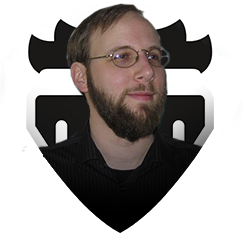
Ethan (along with Shawn Main) was one of the first people to ever try out my very first Commander Draft prototype—and I was so happy to bring him on board as my strong second on this team. Not only is he truly a great designer, but his deep lore knowledge ended up being incredibly useful when working on Commander Legends, and there are a number of deep story cuts he is responsible for. As a huge Commander player, he also managed to finally get a few pet effects onto cards that I think you will all really enjoy.
Robert Schuster
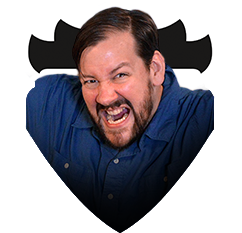
Before the official team started and the project was greenlit, it was part of a Hackathon—a weeklong period where we pause other work to explore new projects. The Hackathon ultimately produced three projects that got made more or less as conceived: Modern Horizons, Jumpstart
. . . and Commander Legends! Rob was one of my two other teammates on that team, and since he was integral to getting the product greenlit, I wanted him here as a designer. Rob really embodies the spirit of Commander and has been an advocate of the format pretty much since the get-go. On top of it all, he's a very kindhearted and hard worker, and always put in the extra effort on the project: I love working with Rob.Andrew Veen
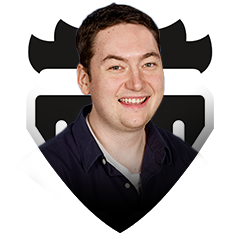
Andrew is a player who not only knows how to destroy you in a competitive game of Magic but also how to have a very fun, social game of Magic. He has a background in the kind of skills Play Design would offer and offered a lot of balance insight to the process. He also has a penchant for being willing to push the boundaries and submit some really out-there ideas, which definitely helped add some spice to the set. Andrew has unfortunately since left Wizards to go elsewhere in the gaming world, but I'm very glad I got to work with him on this project.
Noah Millrod
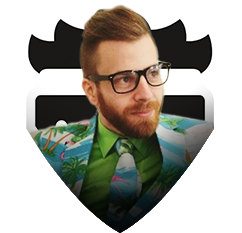
Something really important to me about Commander is that when we're making the product, we're pulling in diverse perspectives because Commander has a very broad playerbase. As a result, I often try to have someone who is not a game designer on a Commander team to offer their insights. Noah is someone from outside of game design at Wizards who I felt really had a budding passion for design and great insight on Commander. Noah did a fantastic job, and since then, his design spark ignited, and he has gone on to be a part of many other design teams.
Gavin Verhey (lead)
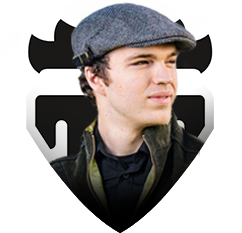
Hey, it's me! I led the vision design for the team. I'm sure you all will be hearing plenty from me around Commander Legends (and check out Good Morning Magic for a new episode every weekday of Commander Legends previews!), so I'll just say this: imagine what you were doing six years ago. Have it in your head? Well, that's not too far from the time I first came up with the idea for Commander Legends. It's been a very long path to this moment, and I really hope you all enjoy the set!
The Vision Design team was responsible for a few things. First, they needed to continue to try and solve the issues of a Commander Draft. Second, they needed to create a general vision of what the set was supposed to be about. Third, they needed to figure out what mechanics the set wanted to use.
#1 – Solving Commander Draft
It turns out that this problem was not a single solution but a combination of a bunch of different things.
Continuing to evolve partner – The Hackathon solution needed to be vetted, and the Vision Design team did that work. Luckily, partner was able to fulfill the job it was added to do. The Vision Design team did decide to use partner only on monocolor legendary creatures (and planeswalkers).
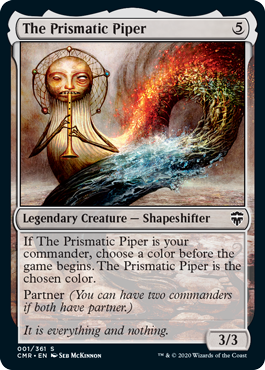

Adding The Prismatic Piper – One of the biggest concerns that came from playtesting was the nervousness that a player wouldn't draft a legendary creature and thus wouldn't have a commander. The solution to that was making a legendary creature that could always work as a backup so that players could draft knowing they'd for sure get a certain color legendary creature if they needed it. The creature was also given partner so that you could also get a second color to go with a monocolor legendary creature with partner that you drafted. The Prismatic Piper was originally a 2/2 for three, but that ended up being something people occasionally played for the body in certain decks, so it was changed to a 3/3 for five, ensuring that it was only being used for the purpose intended. Through all of vison design, it only got used once, but its existence really helped calm drafters' nerves.
Making booster pack options – The Vision Design team decided that they needed to examine all the different possibilities for what size booster the product wanted. Once they knew they were drafting 60 cards, they ended up with two options—15-card packs (that you would draft four of) or 20-card packs (that you would draft three of). Vision Design handed both options off to Set Design to figure out which one worked best.
#2 – Setting the Vision
First and foremost, this product was about being able to draft Commander, but that didn't mean there weren't other things to nail down.
The division between Commander Constructed and Commander Sealed – I explained this above (60-card decks, duplicates being allowed, etc.), but this is where this philosophy got cemented.
The set should be more casual focused – Being a Commander-focused set was about more than just being a Commander set, it also was about being a set that appealed to the type of players that played Commander, and this meant a more casual crowd. This sentiment started in the Hackathon with the adding of cascade, but the Vision Design team wanted the idea applied to the whole set.
The set should lean into nostalgia – Besides being more casual, the Commander crowd tends to be a little more enfranchised. Playing a format where you have access to most the cards from over 27 years means you were more likely to enjoy new cards that referenced the past of the game. One of the things Gavin and his team were very set on was the idea that many of the legendary creatures in the set should be old characters, some of which had never had cards.
Which brings me to my preview cards. Gavin worked closely with the set's original creative liaison, Kelly Digges, to find some fan-favorite characters that had yet to appear on a card. One was a planeswalker (Gavin wanted a couple monocolor planeswalkers with partner) who did a lot of bad things, including trying to kill Urza when they teamed up together. Click below to see Tevesh Szat.
Click to see Tevesh Szat, Doom of Fools
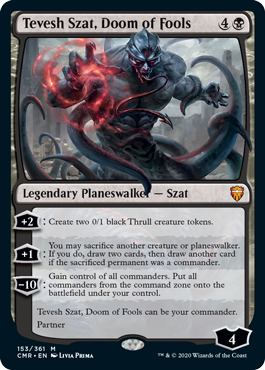
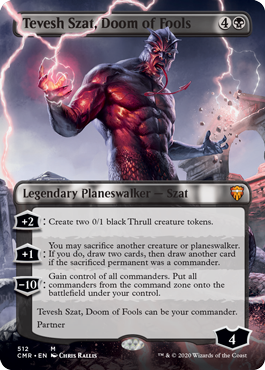
Tevesh Szat was one of Magic's earliest villains, first being referenced in Ice Age. He was also one of the Nine Titans Urza gathered together to attack Phyrexia. Tevesh Szat betrayed Urza (but Urza had predicted Szat would act as such to avoid a "moral dilemma" of how to power up some soul bombs he needed to attack Phyrexia). This card references his origins in Sarpadia (where Fallen Empires was set) and his vile plan to sacrifice Urza.
Mythic rare has a cycle of monocolor legendary cards with partner, of which Tevesh Szat is the black one. Each of these characters gets a card, which is also a part of a cycle. Click below to see Szat's Will.
Click to see Szat's Will
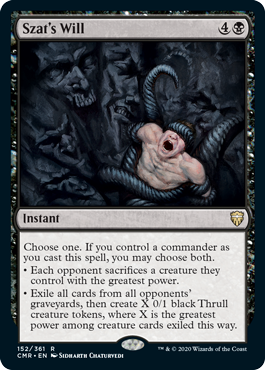
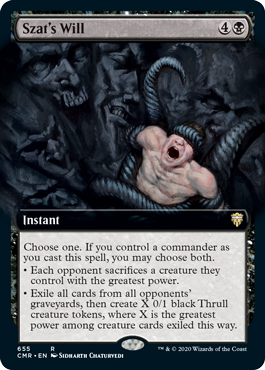
This cycle is all modal cards that allow you to do both modes if you control the proper commander. Again, this card plays into Tevesh Szat's past.
Finally, Commander Legends also has a bunch of reprints that are Commander staples to help more players get their hands on them. To see one such reprint, click below.
Click to see Vampiric Tutor
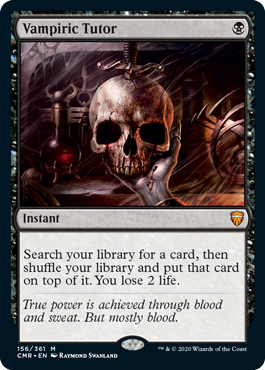
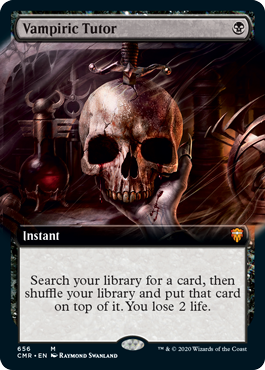
#3 – Finding Mechanics
The Vision Design team ended up adding two mechanics to the set, one that made it to print and one that did not.
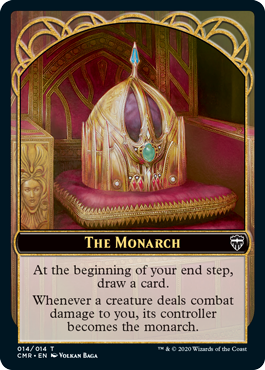
Monarch
This mechanic first showed up in Conspiracy: Take the Crown and has become a popular multiplayer mechanic. Multiplayer games have a tendency to stall, and the monarch mechanic encourages attacking, which helps end the game. Gavin was visiting Shawn Main, and the two ended up talking about how much they liked the monarch mechanic. Gavin came back from his trip and added it to the file. The Vision Design team (and later, the Set Design team) all recognized that Commander players would be very happy to see this mechanic return.
Advocate
This mechanic was a triggered mechanic (like landfall or constellation) that trigged whenever your commander entered the battlefield or attacked. I'll talk more about why it was cut from the set next week.
At Vision's End
At this point in our story, Gavin and his Vision Design team handed off the file to Jules Robins and his Set Design team, which is where we end for today. Next week, I'll pick up the story as Set Design gets their hands on the set. As always, I'm eager for any feedback about today's column or Commander Legends in general. You can email me or contact me through any of my social media accounts (Twitter, Tumblr, Instagram, and TikTok).
Join me next week for Part 2 of our story.
Until then, may you enjoy drafting Commander.
#785: Scott Larabee
#785: Scott Larabee
30:07
In this podcast, I interview Scott Larabee, the esports senior league operations manager. We talk about his many years of running tournaments.
#786: Oozes
#786: Oozes
33:26
Magic has 32 Oozes. (I'm not talking about you, Changelings.) I talk about them all.
- Episode 784 It's All Magic
- Episode 783 Jules Robins
- Episode 782 Red-White

